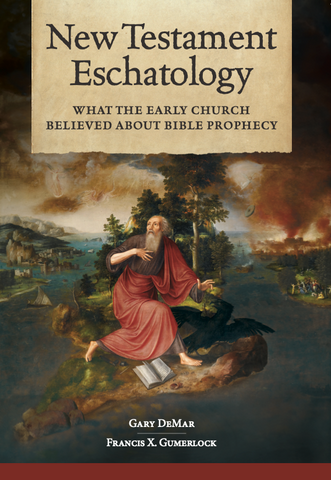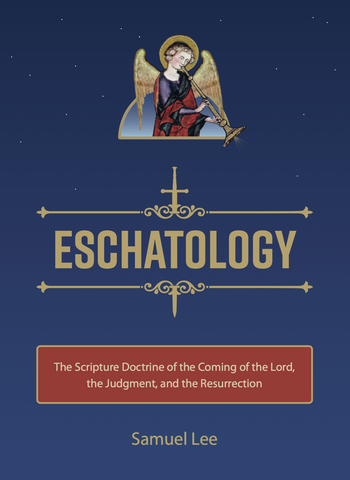The debate over eschatology continues, although there are some who argue there is no debate except on some minor points. We’re told the fundamentals have been settled even when there is still so much disagreement about the millennium, five different rapture positions, whether there is something called “the rapture of the church,” Jesus coming for His saints and Jesus coming with His saints, whether there’s a timeless distinction between Israel and the church, will the cosmos be burned up, the new heavens and the new earth, and so much more.
Many of these detailed disagreements could be settled if interpreters paid closer attention to audience relevance and timing indicators. What passages refer to the coming of Jesus in judgment in AD 70 and which passages refer to what is described as Jesus’ second coming? On this point, there is no consensus, even among those who apply most coming passages found in the New Testament to what Jesus predicted in Matthew 24:34. I’ve been asking for a response to this issue but have not yet seen an exegetical one.
We don’t know what every Christian in history believed about every prophetic passage in the Bible. Most ministers and many theologians over the centuries never published their views. It’s the same today. Most Bible students never publish their views or questions. Some are afraid of being ostracized or thrown out of their churches. Here’s one of many examples.
After reading Last Days Madness, I taught the preterist view on Matthew 24 in our Bible studies at our church. The result? I was removed by the church board because they did not agree with the preterist view. I pastored them for 14 years. I came to realize just how Christians can become very hateful when it came to eschatology.
The preterist interpretation of Matthew 24 has a long and respected history. Any church or pastor that does not know this is uneducated on the topic.

New Testament Eschatology: What the Early Church Believed About Bible Prophecy
Since the futurist perspective has been promoted as an early church reality by so many for so long, few question it. New Testament Eschatology challenges this prevailing futurist view with a careful study of the historical record. The evidence shows that many early church writers understood the destruction of Jerusalem in AD 70 to be the end of the Old Covenant world.
Buy NowAn investigation of theological works published in the past 400 years, many of them hard to find, will show a variety of interpretations of prophetic passages. Some of these works, some going back more than 1500 years, have never been translated into English. Frank Gumerlock’s book Revelation and the First Century makes this point and seeks a remedy.
Theologians going back hundreds of years were aware of the paucity of works that focused on a consistent prophetic hermeneutic. Timothy Dwight (1752-1817) wrote an interesting essay on 1 Corinthians 15.[1]
Many Christians interested in the debate over eschatology are familiar with J. Stuart Russell’s book The Parousia: The New Testament Doctrine of Our Lord’s Second Coming, first published in 1878 anonymously because he knew the pushback he would get. The second edition was published in 1887 that carried his name. Russell said of the publication of The Parousia in the Preface to the New Edition, “It was hardly expected that views, which come into conflict with traditional and popular opinion, should meet with ready concurrence; but the author must confess his disappointment that no serious attempt has been made to disprove any of his positions. The work is almost wholly exegetical; and there is no attempt to invent or establish a theory, but only, by honest and faithful interpretation of the New Testament Scriptures, to allow them to speak for themselves.[2]
Israel Warren also published a book with the title The Parousia: A Critical Study of the Scripture Doctrines Of Christ’s Second Coming, His Reign as King, the Resurrection of the Dead and the General Resurrection in 1879, the same year of Russell’s first edition. There is also Ebenezer Nisbet’s 1877 book The Resurrection of the Bible. Long before the works of Max King and Sam Frost, theologians were asking questions related to Christ’s coming and the nature of the resurrection body. Steve Gregg writes, “In the 1970s, Max King, a minister in the Churches of Christ, began to promote a radical theological system which he called Transmillennialism—also called Covenant Eschatology. Today it is better known by the labels Full-Preterism or Hyper-Preterism. Building on the ideas of nineteenth-century thinkers like James Stuart Russell and Milton Terry, who had interpreted most of the eschatological passages in scripture as referring to the destruction of Jerusalem in A.D. 70, King went so far as to say that every prophecy in the Bible was fulfilled no later than that event.”[3] Max King was not the first to raise questions, and he wasn’t the last. Thomas Rattray published The Regal Advent, and the Resurrection, of the Past in 1878. He wrote the following in the Preface:
The subject of the regal advent as accomplished in A.D. 70, is not a novelty. The learned Grotius of the seventeenth century, and some others of note in that and subsequent times advocated it. In the last century there were men of eminence who admitted the force of Scripture as on its side, and in this century there are learned and pious men who say and write a little in its favour, yet are seemingly deterred from an open advocacy by the almost universal belief in it as to be at the end of time.
Before these four influential works, Samuel Lee published Eschatology, Or, The Scripture Doctrine of the Coming of the Lord, the Judgment, and the Resurrection in 1859.

Eschatology, or The Scripture Doctrine of the Coming of the Lord, the Judgment, and the Resurrection
The preterist interpretation of Matthew 24 has a long and respected history. Any church or pastor that does not know this is uneducated on the topic. Samuel Lee published Eschatology, Or, The Scripture Doctrine of the Coming of the Lord, the Judgment, and the Resurrection in 1859. What’s lacking in so much of today’s scholarship is the willingness to let Scripture interpret Scripture even if the results may call for a refinement of long-held prophetic views.
Buy NowLee “attempted to gain some definite views on the subject presented in this volume. He consulted authors, and especially commentators. The effect was ‘confusion worse confounded.’ He then, as the only hope, went directly and alone to the volume of Inspiration, and attempted to study the Scriptures scripturally,—to make the Bible its own interpreter. The language of the Saviour can be understood only as we know the circumstances in which it was uttered, and especially the character and opinions of the persons addressed…. The Saviour meant to say and did say what he knew his honest hearers would understand him to say.”
What a novel idea! Of course, the place to start and remain is with Scripture since the Bible is the best interpreter of itself. Lee goes to extraordinary lengths to cover some of the most difficult prophetic passages. His exegetical work sheds light on them and counters much of today’s prophetic speculation and reluctance to step outside the interpretive box because of creedal and confessional constraints. What’s lacking in so much of today’s scholarship is the willingness to let Scripture interpret Scripture even if the results may call for a refinement of long-held prophetic views.
[1] Sermon CLXV, “The Remoter Consequences of Death—the Resurrection,” Theology Explained and Defended in a Series of Sermons (Glasgow, 1831), 810-815.
[2] Russell, The Parousia, xi.
[3] Steve Gregg, Why Not Full-Preterism?: A Partial-Preterist Response to a Novel Theological Innovation (Xulon Press, 2022), 153.

